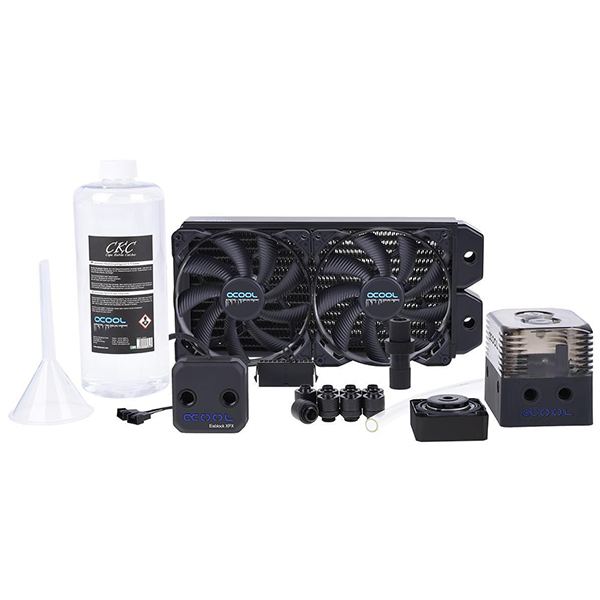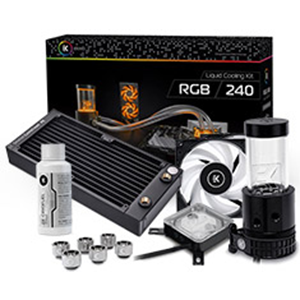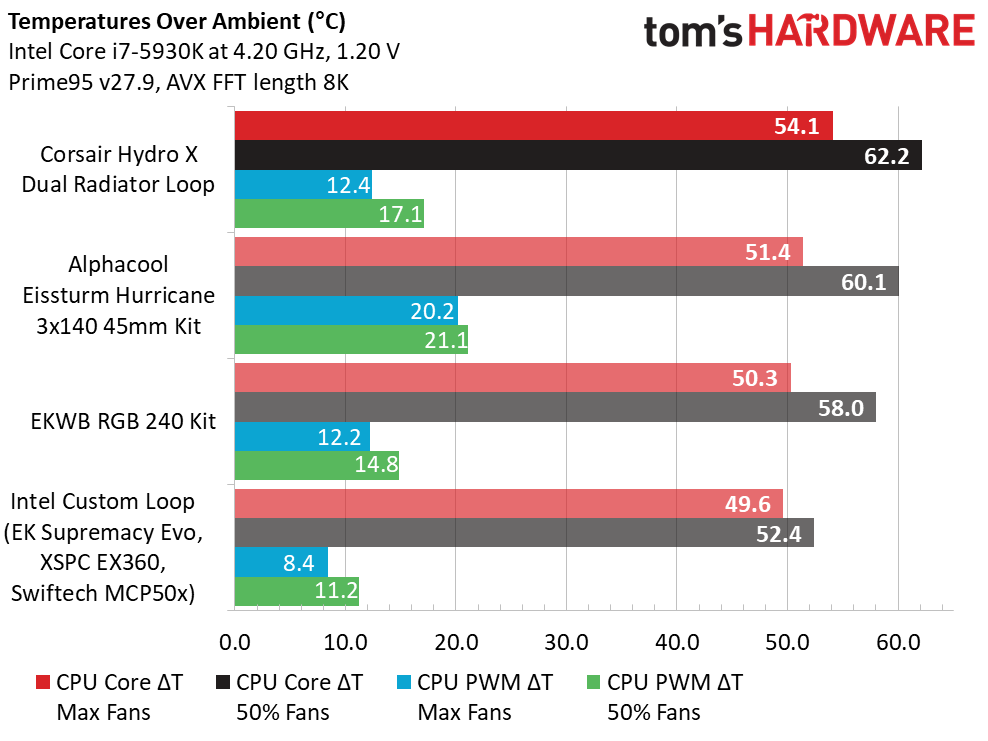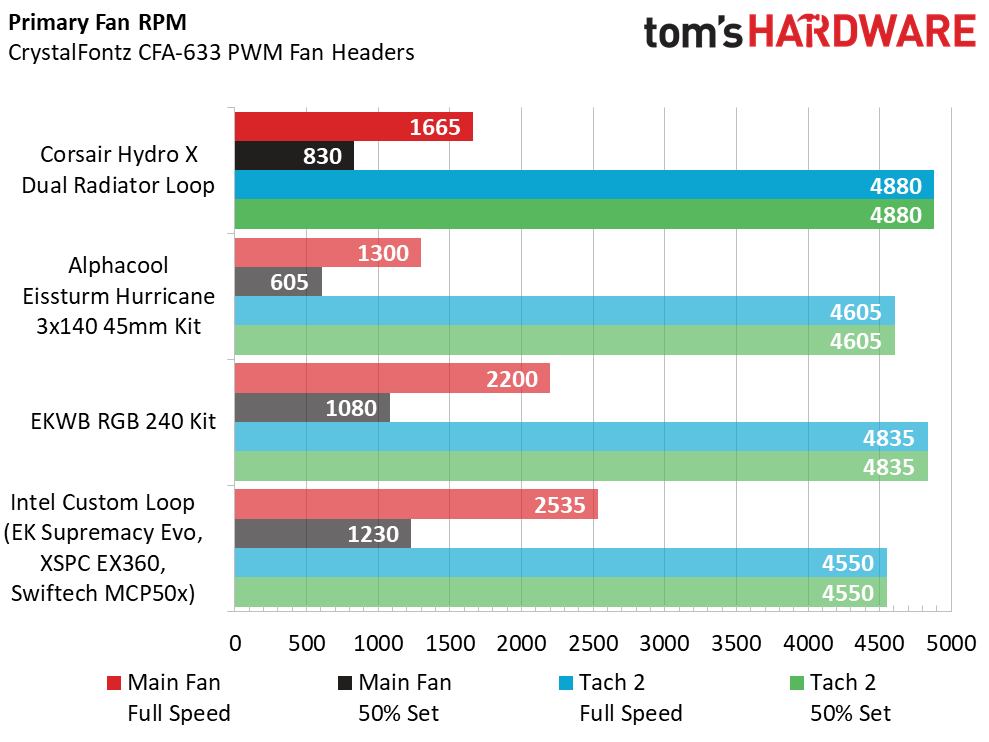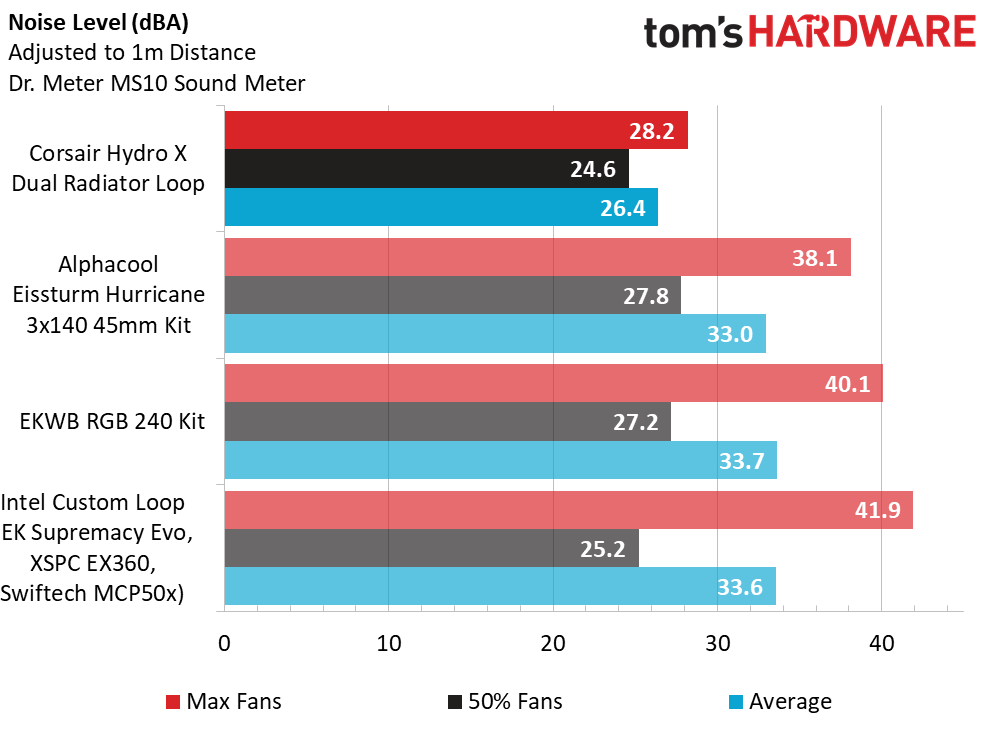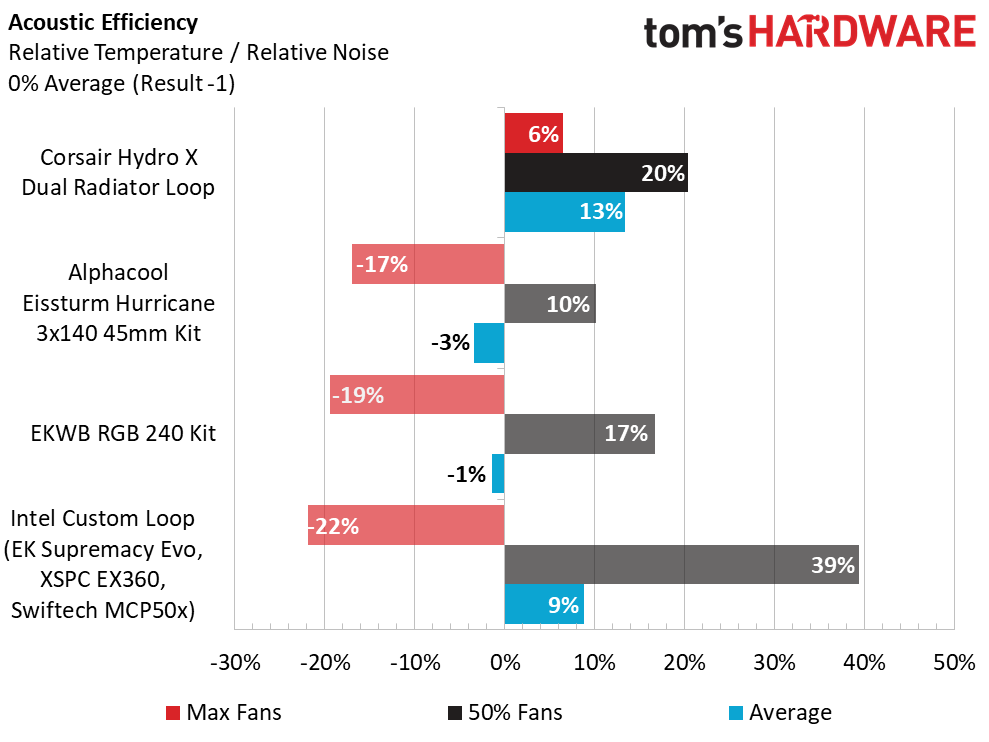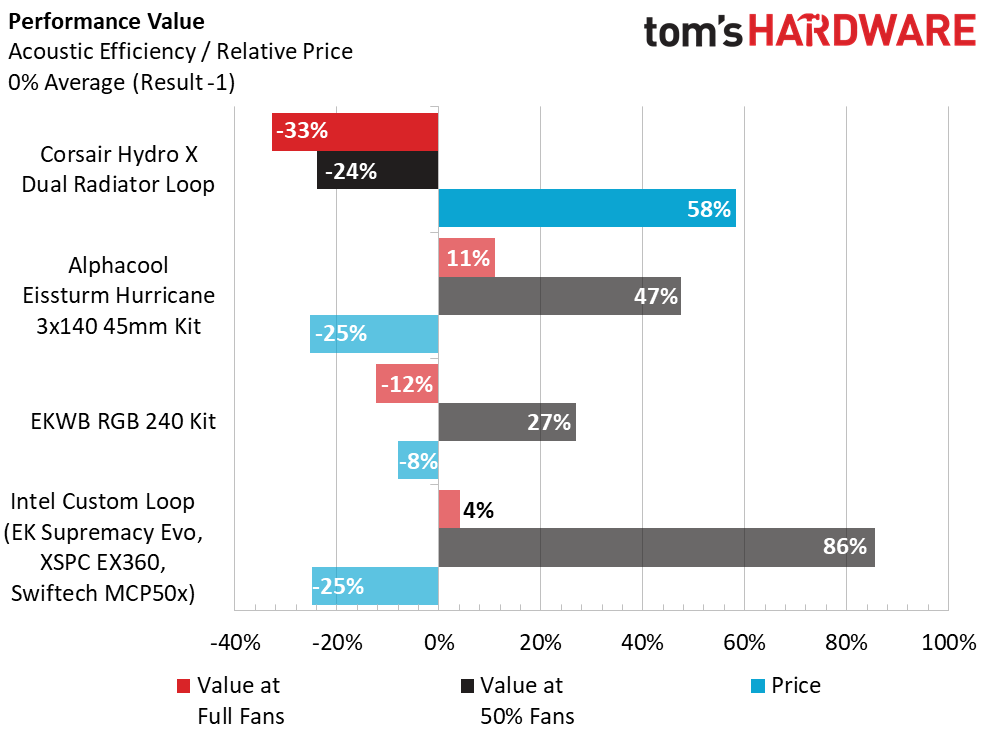Corsair Hydro X Series Watercooling Kit Review: a Serious Custom Cooling Contender
Why you can trust Tom's Hardware
Comparison Coolers, Testing Results and Conclusion
Comparison Coolers
Custom watercooling is rarely perceived to be a remarkable price value, but the custom cooling hobby does offer personal design and aesthetic value to those who dare put water within a computer chassis. We’ll showcase the excessive Corsair, dual radiator loop build alongside a few other watercooling kits that we’ve featured over time here on TomsHardware.com as part of our CPU cooling comparisons. The same Intel i7, 5930K clocked at 4.2Ghz and 1.20v has been used across all tests, inside our Corsair Carbide 760T chassis.
Typical cooler logic would suggest that thermal load temperatures would usually favor the setup with the largest radiator, but in our build utilizing the 360mm + 240mm worth of XR5 radiators, the Corsair configuration slips slightly behind. However, this likely points more towards the efficiencies of the CPU blocks themselves, with the offerings from both EKWB and Alphacool sitting just a few degrees cooler, although a difference of 4.5° C between highest and lowest temperatures is an acceptably tight comparison range.
The 140mm fans used in the Alphacool Eissturm kit obviously spin slower than the 120mm fans present on the other radiators. The Intel Custom loop is the only one to use a DDC-based pump in the MCP50x, while the remaining three use a variant of the DDC’s larger sibling, the Laing D5. Both are fully capable of supporting any of these loops (+ expansion) due to generous flow rate and head pressure specs.
The ML120 Pro fans supplied to us from Corsair are incredibly quiet, at both full- and half-speeds, as shown by the dB chart. Not only does the noise level address the actual fans, it also represents a perspective on the pairing of the fans used for the radiators chosen. Conversely, the higher RPM fans used in the EKWB RGB kit as well as our lab-chosen 3000 RPM (rated) Ultra Kaze fans negatively impact the overall group average.
A relatively tight thermal grouping and sloped noise level comparison leads us to an acoustic efficiency chart that favors the interesting comparison between that of of the best thermal performance and worst acoustics (the Intel custom loop) against the worst thermal performance (+4.5° C) and best noise level in the Corsair Hydro X loop.
Our part selection for the Corsair Hydro X cooling loop skews the price and acoustic efficiency chart, and while it is more expansive than each of the other cooling loops in the comparison, it does support the fact that custom watercooling, while incredibly enjoyable and personalized, does get quite expensive, quite fast. This really hits hard on our performance value chart, where some narrow margins on decibel levels and degrees Celsius separated all 4 cooling loops and where cost starts to make an impact.
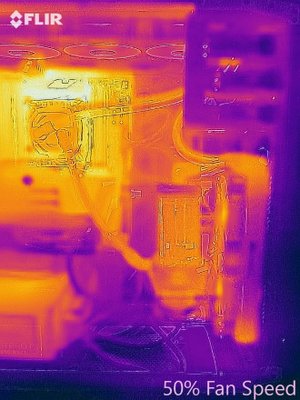
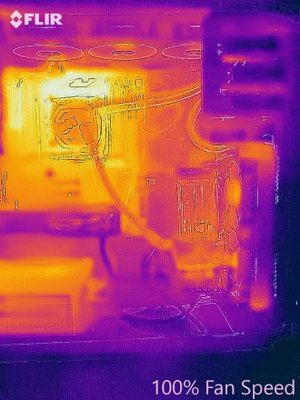
Thermal imaging from our FLIR ONE Pro shows little difference between 50% and 100% fan speed, although slight variations are evident in the tubing runs and radiators, especially the end tanks of the vertically mounted XR5 240mm at the front intake. With 5x120mm worth of radiator surface area, the cooling potential of both radiators means that the heat signature of each barely registers higher than some of the nearby chassis components, such as the upper, front drive bay rack. The effectiveness and efficiency of this high-flowing watercooling loop is clearly evident when it becomes difficult to detect which photo represents full or half-speed fans from our FLIR photos.
Get Tom's Hardware's best news and in-depth reviews, straight to your inbox.
Since the Hydro X components aren’t part of a dedicated kit like the Alphacool Eissturm Hurricane and the EKWB RGB 240, there are definitely some places where we can free up some of this extra, spent cash in our setup. One would be the to omit the use of the 45- and 90-degree XF Adapter elbows and simply use the XF Compression fittings and some longer bends of the Softline tubing, or even go with low-cost tubing barbs. Utilizing hardline tubing would equate to similar costs as softline tubing with compression fittings, while also offering the ability of providing more visually appealing tubing runs, assuming one is adept with a heat gun and bending PMMA tubing.
Another potential savings could be through the omission of the iCue Commander Pro fan and RGB controller by instead relying on integrated motherboard RGB and PWM controls, although wrangling that many fans could become quite a chore without a dual-purpose controller like the Commander Pro.
Lastly, we could opt to use different fans than the Corsair ML120 Pro RGBs, which at $99.99 per 3-pack, puts each fan at a premium price of $33.33, and we required two sets (5 fans total) to mount to our 240 and 360 XR5 radiators.
Since Corsair currently sells its Hydro X components individually, you are free to mix and match your custom watercooling components as you choose, even if you’re choosing some parts from another vendor. This means a system builder looking for a great RGB-accented and coordinated watercooling build now has the opportunity to utilize high-end, enthusiast grade hardware from another company. And Corsair's Hydro X configurator page is second to none, making it a good option for someone building their first custom loop.
While the Hydro X line may not break new ground in terms of performance, price or features, the lineup is robust and well designed, with a slick web-based setup that lets you choose the parts you need based on a slew of popular cases, from Corsair and others. If you're looking to step into the wild world of custom cooling, particularly if you're a novice or you already have some compatible Corsair fans and lighting hardware, Hydro X is well worth considering.
Image Credits: Tom's Hardware
MORE: Best CPU Cooling
MORE: How To Choose A CPU Cooler
MORE: All Cooling Content
- 1
- 2
Current page: Comparison Coolers, Testing Results and Conclusion
Prev Page Features and Specifications
Garrett Carver is a contributor for Tom’s Hardware, primarily covering thermal compound comparisons and CPU cooling reviews; both air and liquid, including multiple variations of each.
-
Giroro "The prices of various parts can add up fast, but that's true of any custom setup."Reply
I must be severely misreading the price list.
Because the list I'm reading says Corsair charges $275 for EIGHT case fans, and $175 on 14 ordinary pipe fittings.
I must be misreading it, because there's no way something so severely overpriced should be getting any kind of official recommendation, least of all Editor's Choice.
Or does just every high-margin product that sends Tom's free gear and an affiliate link get an editor's choice badge now? -
rubix_1011 ReplyAlistairAB said:$800 to get the same OC as a $60 Noctua cooler.
It isn't necessarily about achieving the same result, its also about the aesthetics and hobby itself. -
rubix_1011 Reply"The prices of various parts can add up fast, but that's true of any custom setup."
I must be severely misreading the price list.
Because the list I'm reading says Corsair charges $275 for EIGHT case fans, and $175 on 14 ordinary pipe fittings.
Each 3x pack of ML120 Pro fans is listed as a retail price of $99.99, and we needed to use two boxes to complete the dual radiator setup. This also included using the Commander Pro RGB and fan controller. So yes, that price is correct for what is shown.
If you have watercooled in your PC building lifetime, spending over $10 per fitting should come as no surprise to you. This has been common for many, many years. In fact, some fittings are closer to $15-$20 a piece, depending on specialty.
I must be misreading it, because there's no way something so severely overpriced should be getting any kind of official recommendation, least of all Editor's Choice.
The recommendation isn't due to 'price or value', it is due to the quality of components, the usefulness of the website to provide build information and the overall user-friendliness of the gear being reviewed. Also, this is the price premium of custom watercooling builds - I would expect the same price would exist if you chose EKWB, Alphacool, Swiftech and others to complete a similar build. My understanding is that you, yourself, are not one to build custom watercooling, but your outrage seems unwarranted.
I think far too often people only see components through one lens: "what is cheap, and what is the best for being cheap?" This doesn't apply to all PC hardware, especially when it comes to enthusiast products. If your budget doesn't afford a $1200 RTX 2080Ti or a $1700 32-core Threadripper CPU, you will likely then be looking at at 2060 or even a 1660Ti. The reality is, not everyone approaches hardware with these same views, so it would seem prudent to compare and evaluate them all as such - there is a very large market for people seeking information on these kinds of parts.
Or does just every high-margin product that sends Tom's free gear and an affiliate link get an editor's choice badge now?
Take a look at several of my previous cooling reviews involving 'big names' and 'high margin products', and you'll see that I rarely offer a 'Recommended' stamp on components that I cover. There is no benefit to me for rating a product higher than another, so I am curious what your basis is for the prior statement? -
jdsim9173 This whole setup is a bad idea, anyone whose done water cooling knows not to mix metals. Gpu block is aluminium and radiators are copper and brass, Aluminum will be very susceptible to galvanic corrosion in contact with copper, assuming that the two metals are also in contact with a common electrolyte (such as water with some ionic content.)Reply
Source -
https://en.wikipedia.org \203a wiki \203a Galvanic_corrosion
Corsairs own web page says do not mix their XL5 coolant with aluminium
https://www.corsair.com/us/en/Categories/Products/Custom-Cooling/Coolant/hydro-x-coolant/p/CX-9060001-WW#tab-tech-specs -
rubix_1011 ReplyGpu block is aluminium
No they're not. The blocks themselves are copper and nickel, only the external bits are aluminum....and those do not come into contact with the coolant. The black heatspreader is alumunim, however that never contacts water so this isn't an issue.
The parts that DO contact water are copper and nickel. Let's try and promote facts, please. -
oczdude8 Wow the website is really sleek, makes it much easier to water cool your PC. I remember it took me days to figure out and plan what I needed and where to buy the parts. That being said, im not too sure how big of a market there is for this, considering enthusiasts often like to mix and match parts/brands. The the pricing doesn't really do it any favors either.Reply
I'm really curious to know if they pre-bend and cut hard tubing to fit perfectly in the case. That would probably make it a much better value. -
rubix_1011 They do not pre-bend the hardline tubing, at least to my knowledge (nor do any other sites I've seen). There are too many factors at play, even if the specific hardware is being used as defined in the configurator, there is always the chance that they might be off 1-2mm somewhere else which could cause leaking and making them responsible for user installation.Reply
